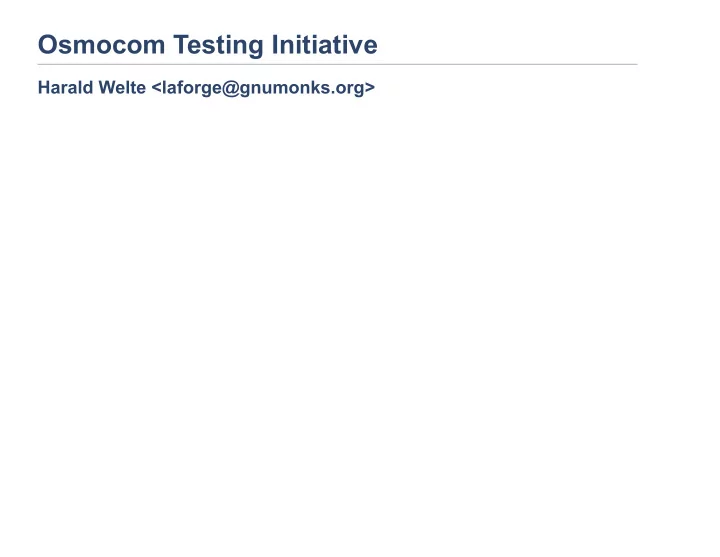

Osmocom Testing Initiative Harald Welte <laforge@gnumonks.org>
split NITB aftermath (the good parts) biggest architectural change since we started in 2008 lots of good reasons and design improvements finite state machines with proper timeouts / clean-up proper 3GPP AoIP with interoperability tesing no synchronous HLR database access HLR access from OsmoMSC and OsmoSGSN 2G/3G authentication over GERAN and UTRAN
split NITB aftermath (the bad parts) never-ending list of breakage actual regressions of things that used to work before things that were known omissions during the restructuring some commercial users stuck with SCCPlite and thus old @osmo-bsc-sccplite@ almost none of the new features or bug fixes there no automatic testing back-ports time-consuming
split NITB aftermath (lessons learned) overall complexity of Osomcoom cellular is quite stunning now absence of proper functional testing has caused massive fall-out the split architecture allows for betteer testing of smaller parts of the system my personal main focus of the last 5+ months: testing, testing, testing, testing testing, testing, testing, testing some more testing even more testing
Osmocom CNI testing (1/2) unit test (autotest, like we always had) test individual functions / APIs of libraries / programs executed during "make check" and hence before any patch can get merged automatized functional tests in TTCN-3 test external visible behavior on interfaces such as Abis, A, GSUP, GTP, MNCC, PCUIF, CTRL, VTY, … executed nightly by Jenkins (could be more frequently)
Osmocom CNI testing (2/2) osmo-gsm-tester tests entire Osmoocom network with BTS/BSC/MSC/HLR/PCU/SGSN/GGSN/… uses real BTS + MS hardware (over coaxial cable) automatic execution multiple times per day interop tests against NG40 RAN + CN simulator from NG4% (A / Gb / Iu level) not fully automatized yet
Osmocom TTCN-3 Test Suites developed in 2017+2018 compiled using Eclipse TITAN uses just a command-line compiler + Makefiles no IDE needed at all, don’t let Eclipse fool you containerized in Docker executed by Jenkins CI
Terminology ATS Abstract Test Suite MTC Main Test Component PTC Parallel Test Component IUT Implementation Under Test
Test Suite Philosophy test one network element (our IUT) test external behavior (3GPP and non-3GPP) emulate entire environment from TTCN-3 don’t reuse Osmocom C-code protocol implementations in the tests test against independent TTCN-3 implementations!
What to test? successful cases erroneous cases (no answer, NACK, …) many difficult to reproduce with real phones/devices load / resource exhaustion spec compliance focus on functionality actually relevant to IUT
Why TTCN-3 + TITAN TTCN-3 specifically designed for telecom protocol testing TITAN team released many telecom protocols in TTCN-3, such as BSSAP, L3 (RR/MM/CC), SMS (CP/RP/TP), SS, M3UA, SCCP, GTP, NS, BSSGP, … shortens our test development cycle permits us to test against known working industry implementations
Test suites for Osmocom CNI components osmo-bts osmo-bsc (for both AoIP and SCCPlite) osmo-msc osmo-mgw osmo-hlr osmo-sip-connector osmo-sgsn osmo-ggsn
Test suites in progress osmo-pcu osmo-bsc_nat osmo-gbproxy
BTS_Tests.ttcn external interfaces A-bis side: RSL (emulates BSC-side server) Um side: L1CTL to control MS PCU side: pcu_socket
BSC_Tests.ttcn external interfaces A-bis side: RSL (emulates BTS-side client) A-side: BSSAP/SCCP/M3UA (emulates MSC-side) MGW side: MGCP (emulates MGW side)
MSC_Tests.ttcn external interfaces A: BSSAP/SCCP/M3UA (emulates BSC-side) MNCC: MNCC/unix-domain (emulates ext. MNCC side) MGW: MGCP (emulates MGW side) GSUP (impllements HLR side)
MGCP_Test.ttcn external interfaces MGCP (emulates call agent) RTP (stream source/sink)
HLR_Tests.ttcn external interfaces GSUP (emulates VLR/SGSN side) VTY
SIP_Tests.ttcn external interfaces MNCC (emulates MSC side) SIP (emulates SIP switch) VTY
SGSN_Tests.ttcn external interfaces Gb (emulates PCU side NS/BSSGP + MS) GSUP (emulates HLR) VTY
GGSN_Tests.ttcn external interfaces Gp: GTP (emulates SGSN) Gi: IP (emulates Internet)
Dockerized Setup one process per container packages either IUT (e.g. osmo-bsc ) ATS (compiled docker test suite) other utility (e.g. trxcon or osmo-bts-omldummy ) why? no need for local ip/network configuration standardized / packaged setup on every machine run older/newer versions of ATS against older/newer IUT
Jenkins CI Execution 1. update docker-playground.git a. contains Dockerfile for ATS + IUT 2. rebuild IUT container[s] (e.g. osmo-bts-master ) a. git magic ensures re-build only if osmo-bts.git master changed 3. rebuild ATS container (e.g. ttcn3-bts-test ) a. git magic ensures re-build only if osmo-ttcn3-hacks.git master changed 4. run docker-playground/ttcn3-bts-test/jenkins.sh a. creates docker network b. starts IUT + ATS docker containers c. collects test results
Jenkins CI Reporting junit-xml generation store artefacts pcap file of every test case ATS log file (TTCN-3 testsuite) IUT log file[s] ( osmo-*.log ) IUT config file[s] ( osmo-*.cfg ) see https://jenkins.osmocom.org/jenkins/view/TTCN3/
Further Reading http://git.osmocom.org/osmo-ttcn3-hacks/ http://git.osmocom.org/docker-playground/ http://osmocom.org/projects/cellular-infrastructure/wiki/Titan_TTCN3_Notes
EOF End of File
Recommend
More recommend